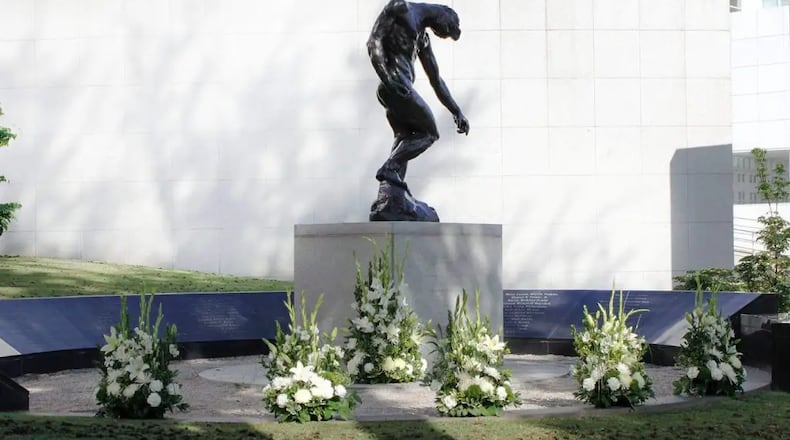The stunning exhibition “Rodin in the United States: Confronting the Modern at the High Museum of Art,” on view through Jan. 15, contains more than 45 sculptures and 25 drawings and presents this sculptor in a new light.
Auguste Rodin is ubiquitous in American culture, but from an artistic perspective, you may have ignored him; not only does he represent the canonical white male European artist boys’ club of the 19th century, but his style has become a cliché of figurative sculpture. His works have been reduced to parodies that grace New Yorker cartoons and jocular greeting cards featuring works such as “The Thinker” (1903) and “The Kiss” (1880-1881), both of which are in this exhibition.
Rodin’s sculptures are sumptuous; their physical presence and sexuality are powerful. Confronting the Modern persuades the viewer that his work can be seen as a carnal and sexual reading of the body in space, simultaneously monumental and intimate and revealing.
Credit: Photography BMA
Credit: Photography BMA
At the High, the exhibition designers have created an exquisite setting for viewing the works that is sensitive to the aura of the sculptures.
Soft curves grace the rectangular galleries in place of their usual right-angled corners. The walls are painted in shades of pale pink, green and gray, creating a space of warmth and lightness that breathes life into these powerful sculptures — all in monochromes of bronze, white, or terra cotta — and the drawings on paper in pencil have underpainted washes of rose and occasional blue that envelop the figure.
Rodin’s process was first to sculpt his works in terra cotta, cast them in plaster, and then cast them again in bronze, sometimes decades later.
His technique of direct modeling gives the works their physicality and presence and uncovers his profound sensitivity to form. He caresses his figures’ flesh, asserting their materiality through the visible gestures on their surfaces that expose his process and touch. One can see the traces of his hands, the gouges and nail marks that reveal his physical process.
Credit: Photography BMA/The Baltimore Mu
Credit: Photography BMA/The Baltimore Mu
Rodin moved away from the ideals of Greek and Roman sculpture and pushed his bodies into the Modern by distorting them and expressing raw emotion through them by his touch and process.
A small study/sculpture, “Study of a hand, modeled ca.1885,” is composed of the body part cut off at the wrist in white plaster. Two fingers are held up vertically and two bent with such grace and expression that the full sensation of life is present.
This study of a hand is eloquent in its simplicity and clarity; the directness of its making and realization provide testimony to Rodin’s virtuosity.
The metaphor of an artist sculpting a hand is not lost on the viewer, as the hand is an artist’s main tool of creation. It also draws attention to the expressivity of the hands in many of the sculptures, and the way Rodin uses hand gestures to convey emotion.
Rodin was fascinated by individual body parts. He cast heads, hands and torsos to use in large group sculptures, such as his “Gates of Hell,” enormous doors filled with a turbulent illustration of Dante’s “Inferno.” Many in Atlanta know “The Shade,” a bronze sculpture at the High of a distorted and elongated male nude body in a slumped-over pose.
This sculpture, which originally was one of the three figures that stand on top of “The Gates of Hell,” was repurposed into a single figure sculpture and given to Atlanta by the French government to honor art patrons who died in a plane crash at Orly Airport in 1962.
Credit: Handout
Credit: Handout
It is a grieving body; it has been on view outside the museum since 1968.
This exhibition is all about the sensuous body, not only in the sculptures but also in Rodin’s drawings, which are erotic in their depictions of female rapture rendered in rough and quick gestures.
When these drawings were first shown in 1908 at Alfred Stieglitz’s Gallery 291, they were considered too erotic for public viewing. They are still powerful and shockingly raw and expressionistic.
Many of the drawings shown at Gallery 291 ended up in American collections because of Stieglitz. “Witch’s Sabbath, ca.1900-05,” a particularly erotic and challenging drawing, was previously owned by Stieglitz’s spouse, the artist Georgia O’Keeffe, who gifted it to the Metropolitan Museum in New York in 1965. What a startling impression Rodin’s exhibition must have had on the 21-year-old O’Keeffe as she ventured to this gallery for the first time to see these scandalous works!
“Witch’s Sabbath” is a sexually explicit drawing in pencil and watercolor wash of a crouching nude woman with her broom across her genitalia. Another Rodin drawing at the High, “Hanako, 1906-1907,” in pen and brown ink, red crayon, graphite and gouache-wash on woven paper, is also from the collection of the Metropolitan Museum.
This drawing is of the Japanese actress Ohta Hisa, known as Hanako. Rodin was obsessed with her. He found her anatomy to be exquisite and refined and made more than 53 masks of her face. In this small sketch, there is a gray wash over her face, which is sketched in pencil. Immediately to its right, her face is repeated as a mask drawn with just a few marks.
This drawing illustrates how Rodin was seeking expression behind the mask of her face, to create and understand the emotion behind the drama.
IF YOU GO
“Rodin in the United States: Confronting the Modern.” Through Jan. 15. $16.50. High Museum of Art, 1280 Peachtree St. NE, Atlanta. 404-733-4400, www.High.org.
Credit: ArtsATL
Credit: ArtsATL
MEET OUR PARTNER
ArtsATL (www.artsatl.org), is a nonprofit organization that plays a critical role in educating and informing audiences about metro Atlanta’s arts and culture. Founded in 2009, ArtsATL’s goal is to help build a sustainable arts community contributing to the economic and cultural health of the city.
If you have any questions about this partnership or others, please contact Senior Manager of Partnerships Nicole Williams at nicole.williams@ajc.com.
Keep Reading
The Latest
Featured






